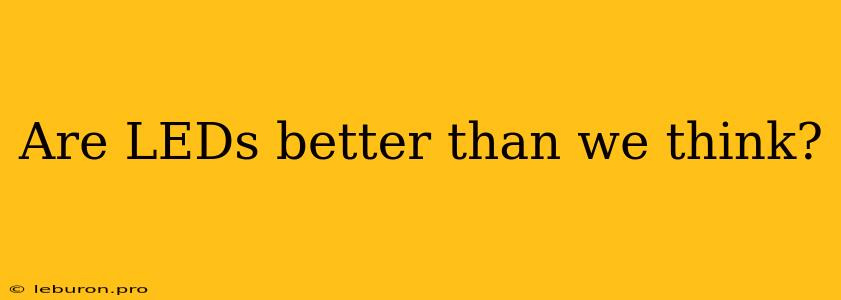The ubiquitous LED light bulb has revolutionized home lighting, offering energy efficiency and a long lifespan. While these benefits are widely recognized, many still harbor doubts about their true performance compared to traditional incandescent bulbs. Are LEDs truly superior in every aspect, or are there potential downsides to consider? This article delves into the advantages and disadvantages of LED lighting, exploring whether they are as good as they seem.
The Rise of LED Lighting
LEDs, or light-emitting diodes, have rapidly gained popularity due to their numerous advantages over traditional lighting technologies. Their energy efficiency is perhaps the most significant benefit. LEDs consume significantly less power than incandescent bulbs, resulting in lower energy bills and a reduced environmental footprint. This energy efficiency is achieved by converting a higher percentage of electrical energy into light, minimizing wasted energy as heat.
Energy Efficiency
LEDs are known for their exceptional energy efficiency, often touted as a key advantage over traditional incandescent bulbs. This efficiency stems from their ability to convert a large portion of electrical energy into light, unlike incandescent bulbs which generate a significant amount of heat as a byproduct. As a result, LEDs use considerably less power to produce the same amount of light, leading to substantial savings on energy bills.
Furthermore, their long lifespan is another significant factor contributing to their overall efficiency. Unlike incandescent bulbs that require frequent replacements, LEDs can last for thousands of hours, reducing the need for bulb changes and the associated waste.
Lifespan and Durability
One of the most compelling reasons to switch to LEDs is their exceptional lifespan. While incandescent bulbs typically last for a few hundred hours, LEDs can operate for thousands of hours before needing replacement. This extended lifespan significantly reduces the need for frequent bulb changes, saving time and money.
Beyond longevity, LEDs are also remarkably durable. Their solid-state design makes them resistant to shocks and vibrations, making them suitable for use in various environments. They can withstand extreme temperatures and are not susceptible to breaking like fragile incandescent bulbs.
Potential Drawbacks of LEDs
While LEDs offer numerous advantages, they are not without their drawbacks. Some users may find the initial purchase price to be higher than traditional bulbs, though the long lifespan and energy savings often offset this cost over time.
Initial Cost
The initial investment in LED lighting can be higher than traditional incandescent bulbs. This price difference is often cited as a barrier to adoption. However, it's essential to consider the long-term benefits, including reduced energy consumption and extended lifespan, which can significantly reduce costs over time.
Color Temperature and Light Quality
The color temperature of LED lights is another aspect that requires consideration. LEDs are available in various color temperatures, ranging from warm white to cool white. Choosing the right color temperature is crucial to creating the desired ambiance in a space. However, some users may find the light quality of LEDs to be less appealing than the warm glow of incandescent bulbs.
Light Quality and Health Concerns
While LEDs offer numerous benefits, some concerns have been raised about their impact on human health. There is ongoing research exploring the potential effects of blue light emitted by some LEDs, particularly on sleep patterns and eye health. Some studies suggest that prolonged exposure to blue light, particularly at night, can disrupt melatonin production, potentially leading to sleep problems. It's important to choose LEDs with a lower blue light emission and to practice responsible lighting practices to minimize potential health risks.
The Verdict: Are LEDs Really Better?
Based on their overall performance, LEDs are indeed better than traditional lighting in many ways. Their energy efficiency, extended lifespan, durability, and versatility make them a compelling choice for both residential and commercial applications. While the initial cost may be higher, the long-term savings in energy costs and reduced bulb replacements often outweigh this initial expense.
However, it's important to acknowledge the potential drawbacks of LEDs. Their light quality may not be universally appealing, and concerns about the potential health effects of blue light warrant further research. Ultimately, the decision to adopt LED lighting is a matter of individual preference, weighing the advantages and disadvantages against specific needs and priorities.
Conclusion
The rise of LED lighting has undoubtedly revolutionized the way we illuminate our homes and workplaces. Their energy efficiency, long lifespan, and durability offer significant benefits, making them a compelling choice for conscious consumers. While some potential drawbacks exist, particularly regarding light quality and potential health concerns, LEDs continue to demonstrate their superiority over traditional lighting technologies. As technology advances, we can expect further improvements in LED performance, further solidifying their position as the future of lighting.
